Weapons - Available - Far East - Photo gallery
Image database with photographs of ancient art and antiquities
Our image database provides photographs of ancient art and antiquities for press releases as well as for private use. All artefacts sold in our gallery are documented through professional photographs. The resulting image library contains numerous ancient Egyptian, Greek and Roman antiquities as well as ancient coins. The time span from Stone Age, over Bronze Age and Classical Antiquity until Late Antiquity is covered.The photo gallery aims at providing a vast visual archive equipped with filters and search tools. You are most welcome to search the constantly growing number of artefacts in the image library. We are also happy to authorize hyperlinks from your webpage / forum to the objects depicted in our gallery. For this purpose, please send us a short notification prior to placing a hyperlink. For almost every object high definition photographs are available and can be provided e.g. to document your collection or for scientific papers or popular science articles. If you are interested in using pictures for publications, print media or other purposes, please contact us and we will be happy to assist you.
-
 Etruscan Vetulonia type helmet
Etruscan Vetulonia type helmetFrom the possession of New York City antiquities dealer Sumner Healey, who was made famous by Berenice Abbott's scenic photograph from 1936.
 Western Asiatic macehead
Western Asiatic maceheadHeavy head of a mace with an ovoid shape. Wonderful veined rock. From Early Bronze Age of the Near East.
 Western Asiatic macehead
Western Asiatic maceheadHeavy head of a mace with a globular shape. Nicely polished stone. From the Early Bronze Age of Western Asia.
 Huge ceremonial knife of the Sican culture
Huge ceremonial knife of the Sican cultureThe so-called Tumi was a weapon to cut the throats of humans and animals in ritual sacrifices. The knife certainly fulfilled an additional representative function in the afterlife. From the period of the Sican's cultural florescence during the 10th to 12th centuries AD.
 Italic bronze belt of a warrior
Italic bronze belt of a warriorStunning samnite bronze work from South Italy. Made in the 5th or 4th century BC, before Romes expansion into Italy. From the famous Guttmann collection.
 Italic bronze belt of a warrior
Italic bronze belt of a warriorNice samnite bronze work from South Italy. Made in the 4th century BC, before Romes expansion into Italy. From the famous Guttmann collection.
 Sword of the Urnfield culture from a museum collection
Sword of the Urnfield culture from a museum collectionWonderfully preserved bronze weapon from the time around 1000 BC. It was made in Central Europe by the Urnfield culture and formed part of a museum collection for almost 70 years.
 Bronze Age casting mould for a lance head
Bronze Age casting mould for a lance headOne half of a stone mould for bronze casting. The equipment is from a workshop of the 2nd Millennium BC, probably from the Carpathian Basin. From the famous Guttmann Collection. This mould was published in a work by Born and Hansen.

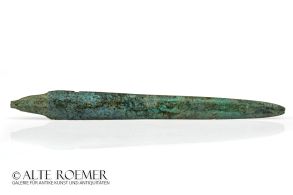 Large Near Eastern lance head
Large Near Eastern lance headDouble-edged blade of a lance from Bronze Age. With a nice green patina.
 Dagger from the Northern European Bronze Age
Dagger from the Northern European Bronze AgeThe double edged blade is from a dagger or short sword of the 2nd Millennium BC. With a nicely cleaned surface with a slight patina.
 Luristan bronze dagger with crescent decoration
Luristan bronze dagger with crescent decorationBronze weapon originating from the Luristan region during Iron Age. With nicely decorated and sturdy blade.
 Three neolithic arrowheads from Egypt
Three neolithic arrowheads from EgyptThe Stone Age points are finely crafted. From a 100 year old museum collection.
 Large ceremonial knife of the Sican culture
Large ceremonial knife of the Sican cultureThe so-called Tumi was a weapon to cut the throats of humans and animals in ritual sacrifices. The knife certainly fulfilled an additional representative function in the afterlife. From the period of the Sican's cultural florescence during the 10th to 12th centuries AD.
 Luristan dagger blade
Luristan dagger bladeDouble-edged bronze blade of a short dagger from the Luristan region in Ancient Iran.
 Luristan bronze dagger
Luristan bronze daggerDouble-edged blade of a short dagger from the Luristan region in Ancient Iran.
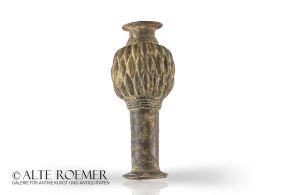 Luristan macehead
Luristan maceheadThe bronze head belonged to a club that was probably worn like a badge of rank in military parades. Very similar finds come from War Kabud and Chamzhi Mumah in what is now Iran.
 Luristan bronze dagger
Luristan bronze daggerDouble-edged blade of a short dagger from the Luristan region in Ancient Iran. An early type from the Middle Bronze Age.

 Luristan bronze dagger
Luristan bronze daggerIron Age bronze weapon originating from the Luristan region in Ancient Iran. Well preserved.
 Luristan bronze dagger
Luristan bronze daggerIron Age bronze weapon originating from the Luristan region in Ancient Iran. Well preserved.
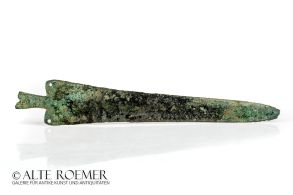
 Near Eastern spearhead
Near Eastern spearheadDouble-edged blade of a spear from Bronze or Early Iron Age. With a nice green patina.
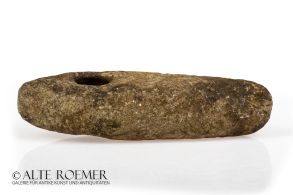 Neolithic axe head
Neolithic axe headThe strong blade was probably used for a battle axe. Crafted from grey rock. An artefact from the Neolithic Age of Europe.
 Sword from the Hallstatt period
Sword from the Hallstatt periodImpressive bronze weapon from the Early Iron Age around 700 BC. Made in the region of today's Germany or surrounding countries.
 Four Scythian arrow heads
Four Scythian arrow headsGroup of four arrowheads made of bronze in excellent condition. Popular weapon of the cultures of the 1st Millennium BC.
 Bronze dagger from North Iran
Bronze dagger from North IranShort bladed weapon from Iron Age Iran. It is probably a find from the province of Gilan in northern Iran.
 Neolithic dagger blade from Denmark
Neolithic dagger blade from DenmarkDouble-edged, pointed blade made of beautiful flint. The blade was for a dagger, the typical status symbol from the transitional period between Late Neolithic and Early Bronze Age.
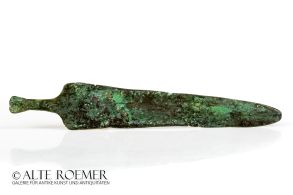 Luristan bronze dagger
Luristan bronze daggerDouble-edged blade of a short dagger from the Luristan region in Ancient Iran. An early type from the Middle Bronze Age.
 Luristan bronze dagger
Luristan bronze daggerDouble-edged blade of a dagger from the Luristan region in Ancient Iran. An early type from the Middle Bronze Age.
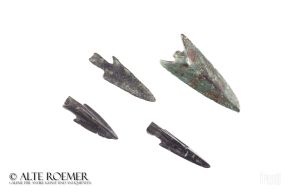 Four Scythian arrow heads
Four Scythian arrow headsGroup of four arrowheads made of bronze in excellent condition. Popular weapon of the cultures of the 1st Millennium BC.
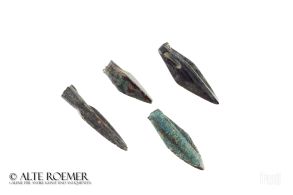 Four Scythian arrow heads
Four Scythian arrow headsGroup of four arrowheads made of bronze in excellent condition. Popular weapon of the cultures of the 1st Millennium BC.
 Neolithic flint dagger from Denmark
Neolithic flint dagger from DenmarkDouble-edged blade and flat shaft made of beautiful flintstone. A status symbol from the transitional period between Late Neolithic and Early Bronze Age.
 Apulian-Corinthian bronze helmet - ex Axel Guttmann collection
Apulian-Corinthian bronze helmet - ex Axel Guttmann collectionWorth the exhibition in a museum. With fine decoration including large boars. Published by H. Born (1993) and M. Junkelmann (2000). Ex Christie's London and Royal Athena Galleries New York.
 Three neolithic arrowheads from Egypt
Three neolithic arrowheads from EgyptThe Stone Age points are finely crafted. From a 100 year old museum collection.
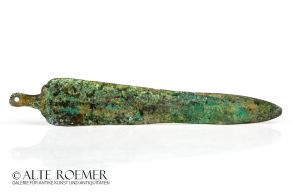 Luristan bronze dagger
Luristan bronze daggerDouble-edged blade of a short dagger from the Luristan region in Ancient Iran. An early type from the Middle Bronze Age.

